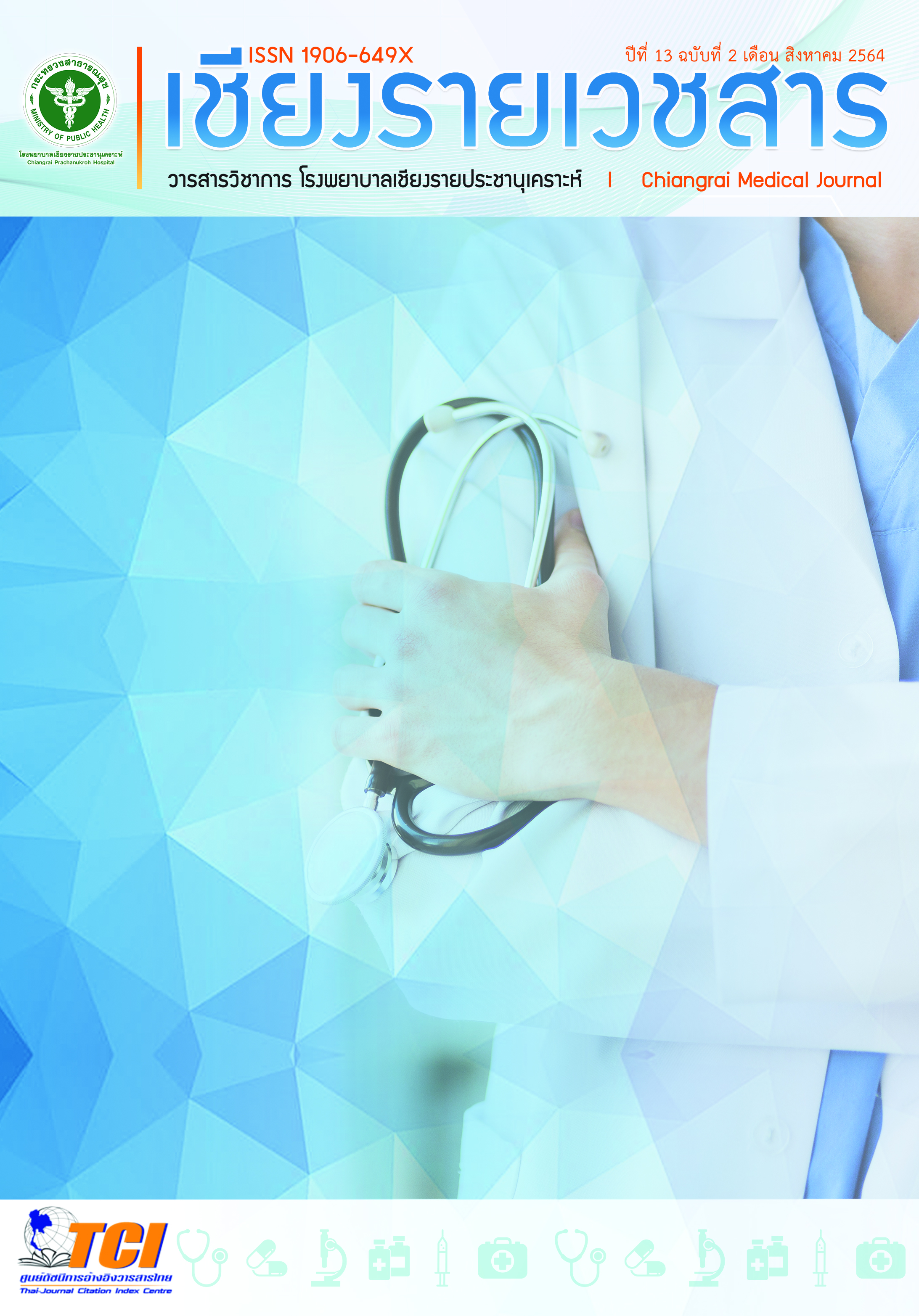PATIENT'S KNOWLEDGE AND ATTITUDE FOR BREAST RECONSTRUCTION AFTER TOTAL MASTECTOMY IN BREAST CANCERS IN CHIANGRAI PRACHANUKROH HOSPITAL
Main Article Content
Abstract
BACKGROUND: Breast cancer is the female most common cancer in Thailand. The necessary treatment is surgery, and breast-conserving is currently a standard. However, the total mastectomy rate conversely is increasing. Breast reconstruction has a role in this group of patients that not only treat the disease, but also improve quality of life. In Chiangrai Prachanukroh Hospital, breast cancer surgery is around 200 cases a year. Nevertheless, the rate of breast reconstruction is only 0.5 %, while the university hospital has a breast reconstruction rate of about 13.45%. In this study, we conduct a short survey to address the possible cause of this low rate.
OBJECTIVE: To study the knowledge and attitude of Post-mastectomy reconstruction in mastectomy patients in Chiangrai Prachanukroh hospital.
METHODS: This descriptive study was conducted with breast cancer, 30 patients with post-mastectomy in 2017 to 2020 and data was collected in the follow up period between October 2020 to January 2021. Data were collected using the demographic data record form, Breast Cancer data, and Questionnaire. Data were analyzed using descriptive statistics.
RESULTS: 30 patients in the study group were all females, with a mean age of 51.77± 8.17 years. 2 patients (6.67%) were contraindicated for breast reconstruction due to inflammatory breast cancer, 5 cases (16.67%) with postoperative radiotherapy were contraindications for immediate breast reconstruction, the remaining 23 patients (59%) were found to be able to perform breast reconstruction after mastectomy. None of the patients had breast reconstruction surgery after mastectomy. From the questionnaire, the answers of the patients in most questions about knowledge were unknown, All patients did not know about breast reconstruction surgery after mastectomy. Most of the patients answered incorrectly in the question about the attitude question in breast reconstruction, and only 5 patients (16.67%) want to do breast reconstruction surgery after breast surgery.
CONCLUSIONS AND DISCUSSIONS: This study showed the lack of patients' knowledge of the Post-mastectomy reconstruction options that may affect the rate of breast reconstruction after total mastectomy. The result of this study can be guided in developing a care model and preoperative information and option of reconstruction will ensure better success of the treatment, which may improve the quality of life in mastectomy patients.
Article Details
References
Imsamran W, Chaiwerawattana A, Wiangnon S, Pongnikorn D, Suwanrungrung K, Sangrajrang S, et al. Cancer in Thailand Volume VIII 2010–2012. Bangkok: National Cancer Institute, Ministry of Public Health Thailand;2015.
Chaiwerawatana A. Breast ICD-10 C50. In: Khuhaprema T, Srivatakul P, Sriplung H, Sumitsawan Y, Attasara P, editors. Cancer in Thailand Vol.IV, 1998-2000. Bangkok:National Cancer Institute, Ministry of Public Health Thailand;2007:p.48-50.
Jatoi I, Proschan MA. Randomized trials of breast-conserving therapy versus mastectomy for primary breast cancer: a pooled analysis of updated results. Am J Clin Oncol. 2005;28(3):289-94.
McGuire KP, Santillan AA, Kaur P, Meade T, Parbhoo J, Mathias M, et al. Are mastectomies on the rise? A 13-year trend analysis of the selection of mastectomy versus breast conservation therapy in 5865 patients. Ann Surg Oncol 2009;16(10):2682-90
Suwajo P, Haetanurak S. Breast reconstruction for mastectomy. Chula Med J 2017;61(6):715-30.
Al-Ghazal SK, Fallowfield L, Blamey RW. Comparison of psychological aspects and patient satisfaction following breast conserving surgery, simple mastectomy and breast reconstruction. Eur J Cancer 2000;36(15):1938-43.
Christian CK, Niland J, Edge SB, Ottesen RA, Hughes ME, Theriault R, et al. A multi-institutional analysis of the socioeconomic determinants of breast reconstruction: a study of the National Comprehensive Cancer Network. Ann Surg 2006;243(2):241-9
Fisher B, Anderson S, Bryant J, Margolese RG, Deutsch M, Fisher ER, et al. Twenty-year follow-up of a randomized trial comparing total mastectomy, lumpectomy, and lumpectomy plus irradiation for the treatment of invasive breast cancer. N Engl J Med 2002;347(16):1233-41.
American Society of Plastic Surgeons. 2015 Plastic surgery statistics report [Internet]. 2015 [cited 2016 Aug 12]. Available from: https:// www.plasticsurgery.org/news/plastic-surgery- statistics
Katipamula R, Degnim AC, Hoskin T, Boughey JC, Loprinzi C, Grant CS, et al. Trends in mastectomy rates at the Mayo Clinic Rochester: effect of surgical year and preoperative magnetic resonance imaging. J Clin Oncol 2009;27(25):4082-8.
Wilkins EG, Cederna PS, Lowery JC, Davis JA, Kim HM, Roth RS, et al. Prospective analysis of psychosocial outcomes in breast reconstruction: one-year postoperative results from the Michigan Breast Reconstruction Outcome Study. Plast Reconstr Surg 2000;106(5):1014-25.
Zhang P, Li CZ, Wu CT, Jiao GM, Yan F, Zhu HC, et al. Comparison of immediate breast reconstruction after mastectomy and mastectomy alone for breast cancer: a meta-analysis. Eur J Surg Oncol. 2017 ;43(2):285-93.
Kronowitz SJ. Delayed-immediate breast reconstruction: technical and timing considerations. Plast Reconstr Surg 2010;125(2):463-74.
American Society of Plastic Surgeons. 2016 Plastic Surgery Statistics Report. [Internet]. 2015 [cited 2016 Aug 12]. Available from: https://www.plasticsurgery.org/documents/News/Statistics/2016/reconstructive-procedures-ethnicity-2016.pdf
Phutivut V,Chiaviriyabunya I. Survival rate of the five most common cancers in 2010at Udothani Cancer hospital Thailand. Thai cancer J 2018;44(1):79-81.
Breast cancer monograph in the year 2014-2018. Bangkok: Breast cancer group, Siriraj Cancer Center and Division of Head neck and Breast Surgery, Department of surgery, Faculty of Medicine Siriraj Hospital, Mahidol University; 2020.


